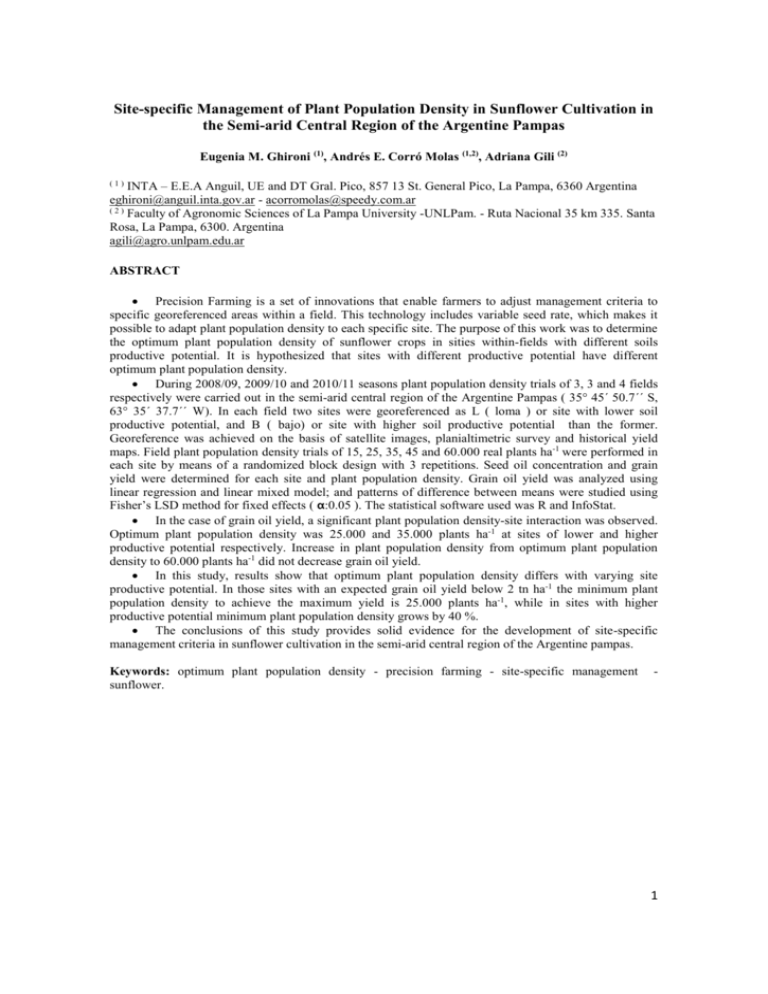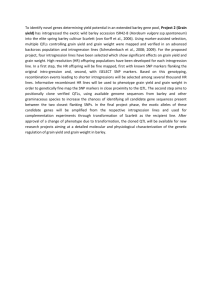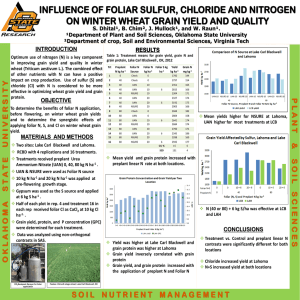Site-specific Management of Plant Population Density in
advertisement

Site-specific Management of Plant Population Density in Sunflower Cultivation in the Semi-arid Central Region of the Argentine Pampas Eugenia M. Ghironi (1), Andrés E. Corró Molas (1,2), Adriana Gili (2) INTA – E.E.A Anguil, UE and DT Gral. Pico, 857 13 St. General Pico, La Pampa, 6360 Argentina eghironi@anguil.inta.gov.ar - acorromolas@speedy.com.ar (2) Faculty of Agronomic Sciences of La Pampa University -UNLPam. - Ruta Nacional 35 km 335. Santa Rosa, La Pampa, 6300. Argentina agili@agro.unlpam.edu.ar (1) ABSTRACT Precision Farming is a set of innovations that enable farmers to adjust management criteria to specific georeferenced areas within a field. This technology includes variable seed rate, which makes it possible to adapt plant population density to each specific site. The purpose of this work was to determine the optimum plant population density of sunflower crops in sities within-fields with different soils productive potential. It is hypothesized that sites with different productive potential have different optimum plant population density. During 2008/09, 2009/10 and 2010/11 seasons plant population density trials of 3, 3 and 4 fields respectively were carried out in the semi-arid central region of the Argentine Pampas ( 35° 45´ 50.7´´ S, 63° 35´ 37.7´´ W). In each field two sites were georeferenced as L ( loma ) or site with lower soil productive potential, and B ( bajo) or site with higher soil productive potential than the former. Georeference was achieved on the basis of satellite images, planialtimetric survey and historical yield maps. Field plant population density trials of 15, 25, 35, 45 and 60.000 real plants ha-1 were performed in each site by means of a randomized block design with 3 repetitions. Seed oil concentration and grain yield were determined for each site and plant population density. Grain oil yield was analyzed using linear regression and linear mixed model; and patterns of difference between means were studied using Fisher’s LSD method for fixed effects ( α:0.05 ). The statistical software used was R and InfoStat. In the case of grain oil yield, a significant plant population density-site interaction was observed. Optimum plant population density was 25.000 and 35.000 plants ha-1 at sites of lower and higher productive potential respectively. Increase in plant population density from optimum plant population density to 60.000 plants ha-1 did not decrease grain oil yield. In this study, results show that optimum plant population density differs with varying site productive potential. In those sites with an expected grain oil yield below 2 tn ha-1 the minimum plant population density to achieve the maximum yield is 25.000 plants ha-1, while in sites with higher productive potential minimum plant population density grows by 40 %. The conclusions of this study provides solid evidence for the development of site-specific management criteria in sunflower cultivation in the semi-arid central region of the Argentine pampas. Keywords: optimum plant population density - precision farming - site-specific management sunflower. - 1 Introduction In the semi-arid central region of the Argentine Pampas water availability in amount and frequency is the main limiting productive factor for crops. The maximum grain yield to be obtained in a given environment depends on the way in which the ontogenic cycle of the crop is able to adjust maximum demand to environmental supply of resources and manage to reduce severe stress occurrence in critical periods (Trapani et al., 2003.) Soil factors such as depth, texture, position in the landscape and presence of a layer of subsurface water available determine significant differences among sites within the same field as they may affect water availability for cultivation (Funaro et al., 2008.) Site-specific management in environments characterized by significant intra-field variation allow enhanced use of inputs to achieve higher efficiency. Andrade et al (2000) mention that in low productive potential sites, where expexted grain yield is medium-low, grain yield is not affected by changes in plant population density within a wide range. Along similar lines, Pereyra et al (2001), couldn’t report significant effects on grain yield within 25.000 – 60.000 plants ha-1 range in environments of low productive potential in the Southeastern Bonaerense Region. On the other hand, in sites of higher productive potential grain yield increases significantly, showing a similar trend in plant population density (Andrade et al., 2000, Pereyra et al., 2001). In practice, the possibility of adjusting inputs to differentiated, georeferenced areas requires the adaptation of site-specific agronomic criteria to local edaphoclimatic conditions. The purpose of this work is to determine the optimum plant population density of sunflower crops in sites within-fields with different soils productive potential in the semi-arid central region of the Argentine Pampas. It is hypothesized that sites with different productive potential have different optimum plant population density. Materials and Methods The experience took place in the dune plains located in the northern part of La Pampa province, at “La Barrancosa” Ranch (35º 45´ 50.7” S, 63º 35´ 37.7” W) not far from General Pico city, during 2008/09, 2009/10 and 2010/11 seasons. In the first two seasons 6 fields were sown (3 in each season), whereas in the last season the number of lots involved was 4. In each field two sites were georeferenced, identified as L ( loma) or site lower soil productive potential, and B ( bajo) or site higher soil productive potential site than the former. This was done by means of satellite imagery, planialtimetric survey and historical yield maps. In each site a plant population densities trial was perfomed in random blocks with 3 repetitions. Trials were conducted with a TX Mega coarse grain Agrometal Seeder of 22 furrows, some features of which were pneumatic direct seeding, deep fertilization and high plant population density. Firstly, plants in line were manually thinned in 2 true leaves, and experimental units of 4 furrows were established 0.52 m. apart and 10 m long with an achieved density of 15.000, 25.000, 35.000, 45.000 and 60.000 plants ha-1. In each field only one hybrid was sown. The plant cultivars used for trial were DK 4200, CF 31, DK 3820, DK 3810, DK 4050 and DK 3945. Cultivation took place at the end of October and end of November. In each site soil samples 0 to 20 cm-thick were taken to determine granulometric fractions (sedimentation), total organic matter (MOT, Walkley and Black), and available forms of phosphorus (P, Bray and Kurtz I). Nitrogen content of nitrates was determined in samples of 0-20 cm and 20-60 cm (Cromotropic Acid). Soil water availability at sowing (gravimetric method) was determined at set intervals of 20 cm up to a depth of 300 cm. In each experimental unit a surface of 5.2m-2 was harvested. All units were threshed, weighed, and their moisture content was measured by means of Tesma Campo hygrometer; oil concentration was measured as well by NIR. Grain yield was adjusted by oil concentration on the basis of the methodology used by Red INTA – ASAGIR (Alvarez D. et al, 2006). Grain yields were statistically analyzed by applying linear regression and linear mixed models –LMM(Littell et al., 2006 ). After application of LMM followed trials to analyze the difference between means using Fisher’s LSD method for fixed effects with a signifiance level of 0.05. The statistical software used was R (R Development Core Team, 2011) and InfoStat ( Di Rienzo et al., 2011). Results Rainfall during crop development (November to February) were variable among years. During 2008/09 season rainfall was 36 % lower than historical average in the area (1921-2010 period), at 230 2 mm. In 2009/10 figure were similar to the historical average at 365 mm. In the last season, however, (2010/11) rainfall was 12% lower at 310 mm. Figure 1 shows the hydric status as observed during the 3 seasons under analysis. Figure 1: Rainfall (R) during sunflower cultivation cycle for 2008/09, 2009/10, 2010/11 seasons, historical average 1921-2008 and average potential evapotranspiration 2008/2011 (PET) Table 1 shows edaphic characterisitcs of each site. Contents of clay + slime, total organic matter and nitrate-nitrogen were higher, whereas phosphorus content was lower in B sites in comparison with L sites. Soil water availability at sowing was always higher in B sites with increases ranging from 1.5 to 8.8 times higher than L sites. In some B sites a layer of subsurface available water ( Napa ) was detected at 2.6 - 3 meter-depth. Table 1: Edaphic characteristics of assessed sites in the semi-arid central region of the Argentine Pampas. 3 Grain oil yield was related to soil water availability at sowing during 2008/09 and 2009/10 seasons (Figure 2), characterized by rainfall below historical average during sunflower critical period (January). These results match the ones observed by Quiroga et al (2008), who found a relationship between water content in the soil and sunflower grain yield in years with scarce rainfall during January. 4 Figure 2: Relationship between soil water availability at sowing and grain oil yield in years with rainfall levels below historical average during January. During the 2010/11 season, which had a rainfall level above historical average in January, there was no relationship whatsoever between soil water availability at sowing and grain oil yield achieved for plant population density averages (R2= 0,2; p=0,14) The analysis of grain oil yield based on the different plant population densities under study showed that variability associated to year, field and hybrids used was not significant. However, the plant population density – site interaction did show differences in average values of grain oil yield ( p< 0,000). Higher loss of grain oil yield was observed when low plant population densities were used in B sites with respect to more limiting environments, such as L sites (Figure 3). Optimum plant population density for sites with higher productive potential was 35.000 plants ha-1, whereas sites with lower productive potential showed a lower optimum plant population density: 25.000 plants ha-1. Figure 3: Grain oil yield sunflower based on the different plant population density for sites having different productive potential (L: lower productive potential, B: higher productive potential) Conclusions Soil water availability at sowing is a highly significant indicator of site productive potential in years with rainfall below average during the critical period. Sites with different productive potential determine different optimum plant population densities. In deep sandy soil sites of the semi-arid central region of the Argentine Pampas, where expected grain oil yield is lower than 2 tn ha-1, optimum plant population density is over 25.000 plants ha-1, whereas at sites with more than 2 tn ha-1 optimum plant population density is 35. 000 plantas ha-1. Based on the conditions analyzed in the present study, in those sites with higher productive potential plant population densities should be approximately 40 % higher than in sites with lower productive potential. References 5 Alvarez D., Firpo R, Qhillehauquy V., Quiroz F. 2006. Red Nacional de Evaluación de Cultivares de Girasol, Información de la Región Centro Ciclos 2004/05 y 2005/06. INTA – ASAGIR. 42 pp. Acceso 18/11/2011: http://www.asagir.org.ar/Publicaciones/cuadernillo10_centro_INT.pdf Andrade y Sadras 2000. Bases para el manejo del maíz, el girasol y la soja. Cap. 4 pag 113-115. Di Rienzo, J.A., Balzarini, M., Gonzalez, L., Casanoves, F., Tablada, M., Robledo, C.W. InfoStat versión 2011. Grupo InfoStat, FCA, Universidad Nacional de Córdoba, Argentina. URL: http://www.infostat.com.ar Funaro D., J. Garay, R. Rivarola, A. Quiroga. 2008. Algunos factores determinantes del rendimiento de girasol en la región semiárida pampeana central. En El cultivo de girasol en la región semiárida pampeana.. 3: 27-32. Ed. INTA. Disponible en: www.inta.gov.ar/anguil/info/pdfs/publicaciones/publi72.pdf Littell, R.C., Milliken, G.A., Stroup, W., Wolfinger, R.D., Schoberenger, O. 2006. SAS System for Mixed Models 2nd ed. SAS Institute Inc. Quiroga A., R. Fernández, I. Frasier, D. Funaro. 2008. Aspectos del manejo del agua. En El cultivo de girasol en la región semiárida pampeana. Ed INTA. 3: 33-38. R Development Core Team 2011. R: A language and environment for statistical computing. R Foundation for statiscal Computing, Vienna, Austria. ISBN 3-900051-07-0, URL http://www.R-proyect.org/. Pereyra, V. R., C. Feoli y H. Sarlangue. 2001. Girasol en Siembra Directa. Cuadernillo Informativo N° 1. ASAGIR, 24 pp Trapani, N., López Pereira, M. Sadras, V.O. y Hall, A.J. 2003. Ciclo ontogénico, dinámica del desarrollo y generación del rendimiento en girasol. En Producción de granos. Bases funcionales para su manejo. Satorre, E.H, Benech-Arnold, R.L., Slafer, G.A., De la Fuente, E.B., Miralles, D.J. , Otegui, M.E. y Savin, R. editores. Cap 10 pp.205-236. Facultad de Agronomía, Universidad de Buenos Aires. 6







